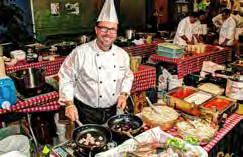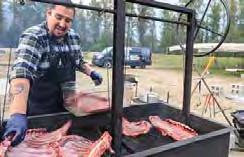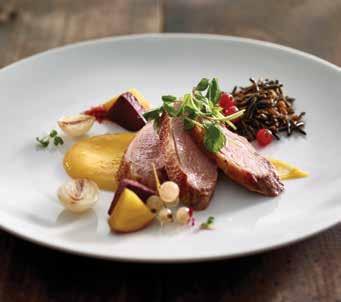

BE TRUE TO THE FOOD®
TRUE INGREDIENTS. TRUE INNOVATION. TRUE PASSION FOR YOUR SUCCESS.

THAI CHICKEN GAI YANG FEATURING CUSTOM CULINARY®





CHEF’S OWN™ SRIRACHA
LIME SEASONING AND SWEET & SMOKY BBQ FLAVOUR GLAZE






At Custom Culinary® we’re dedicated to providing exceptional products to enhance any menu and every daypart. Our avour-forward solutions are rooted in culinary expertise and a thoughtful, innovative approach to product development, centred on clean, simple and wholesome ingredients. We bring pro table trends to life with items that meet your needs, delight your customers and exceed your expectations. Learn how we can help you Be True To The Food® by visiting CUSTOMCULINARY.CA.
© 2023 Custom Culinary,




















“ ”
A SEASON OF CHANGE
Loooking back on the last few years and into the future, we can start to appreciate some of the lessons we’ve learned and the progress we’ve made. As the industry’s recovery continues, we’ve relied on strength, resilience, and perseverance as a few of the tools of our trade to thrive, despite ongoing inflation, labour shortages, and supply chain delays.
This spring 2023 issue of Canadian Restaurant & Foodservice News looks at the industry’s bright future, highlighting modern innovation, top trends, and valuable solutions as we continue to grow and evolve.
Our cover story talks tech, with insight from a number of industry experts, including Compass Canada, The Fifteen Group, Givex, OpenTable, and SJW Robotics. This roundtable dives into restaurant technology and its influence on the industry, from reservations to robots, and more.
Our Canadian Trailblazer story sheds light on food waste, a consistent challenge to the foodservice industry, bearing even more weight as it continues to reach record highs, increasing the need for restaurants to lower waste and cut costs. Second Harvest’s app comes to the rescue, connecting food sources, non-profit organizations, and people in need, to redistribute surplus edible food across the country.
As operators continue to strive to engage their customers, we cover cool cocktail trends to jazz up your menu, staffing and labour, and the best ways to connect with your customers by soliciting and responding to online reviews. We also look at restaurant design, highlighting patio accessibility as a way of welcoming everyone to your restaurant.
This issue’s Chef Q&A includes Chica’s Chicken in Toronto, one of the winners of the Michelin Bib Gourmand designation, which recognizes restaurants with delicious food and affordable pricing. We take a look at how the ‘Bib’ affects the industry, the community, and consumer access to awardwinning restaurants.
Our Culinary Federation insert, A la Minute, covers this year’s annual conference, celebrating the last six decades of culinary excellence. Growing into more than just an association, the CF reflects on the last 60 years, sharing some of its best memories and milestones.
Overall, this issue takes a look at the future of the foodservice industry as we move through 2023, forging a new path to success with trends, tools, and technology.
Can’t wait for you to read this issue!
Jessica Brill jessicab@mediaedge.caCanadian Restaurant Foodservice News & &
PUBLISHER: Chuck Nervick chuckn@mediaedge.ca
EDITOR: Jessica Brill jessicab@mediaedge.ca
DIGITAL MEDIA DIRECTOR: Steven Chester stevenc@mediaedge.ca
ART DIRECTOR: Annette Carlucci
GRAPHIC DESIGNER: Thuy Huynh
PRODUCTION MANAGER: Ines Louis inesl@mediaedge.ca
CIRCULATION INQUIRIES: Adrian Holland circulation@mediaedge.ca
CONTRIBUTING WRITERS: Katie Belflower, Samantha Des Jardins, Mark Plumlee
Magazine Editorial Advisory Board
Jason Bangerter
Executive Chef, Langdon Hall Country House Hotel and Spa
Donna Bottrell, RD
Owner, Donna Bottrell Food Consulting

Andrea Carlson
Chef/Owner, Burdock and Co.
Connie DeSousa and John Jackson
Co-owners/chefs, Charcut/Charbar
Jeff Dover
Principal, fsSTRATEGY
Ryan Marquis Corporate Chef, CW Shasky
Gary McBlain
National Director of Culinary ServicesAmica Mature Lifestyles Inc.
Brent Poulton
CEO, St. Louis Bar and Grill
Doug Radkey
Owner and Director of Operations
Key Restaurant Group
Matt Rolfe
CEO and Hospitality Leadership Coach/Speaker, Results Hospitality
PRESIDENT: Kevin Brown
SENIOR VICE PRESIDENT: Chuck Nervick
Published by: MediaEdge Communications Inc.
2001 Sheppard Avenue East, Suite 500 | Toronto, Ontario M2J 4Z8
Tel: 1-866-216-0860 Fax: 416-512-8344
E-mail: info@mediaedge.ca | Website: www.restobiz.ca
Copyright 2023
Subscription Rates:
Canada: 1 year, $50*, 2 years, $90*, US $75, International $100
Single Copy Sales: Canada: $12*
* Plus applicable taxes
Publications Mail Agreement No: 40033126 PAP Registration No. 10983
ISSN 1494-7625. We acknowledge the financial support of the Government of Canada through the Publications Assistance Program towards our mailing costs.
Views expressed are not necessarily those of Canadian Restaurant & Foodservice News or the editorial staff. Although every care will be taken of material submitted for publication, Canadian Restaurant & Foodservice News, its servants or agents accept no responsibility for their loss, damage or destruction arising while in its offices, in transit or otherwise.

FOOD RESCUE: THERE’S AN APP FOR THAT
Second Harvest’s Food Rescue App makes it easy for restaurants and food businesses to help tackle food waste and insecurity
 By Jessica Brill
Photo courtesy of Second Harvest
By Jessica Brill
Photo courtesy of Second Harvest
Food waste has always presented a challenge to the foodservice industry, but as inflation continues to reach record highs, restaurants may even be more motivated to lower waste and cut costs. From tightening up inventory to better managing offpremise orders, there’s an opportunity for the foodservice industry to waste less, lower its carbon footprint, and help address Canada’s battle with food insecurity.
The issue of food waste is a very serious problem in our country, where an enormous amount of surplus food — defined as food that is not consumed before reaching its “best before” date — is sent to the landfill each year. While we may not be able to completely eradicate waste, we can redistribute surplus edible food, especially as 6.7 million Canadians are using nonprofit food services annually.
“There’s just so much need out there for food rescue, from the supply chain end to feeding the people to protecting the environment,” says Lori Nikkel, CEO, of Second Harvest, Canada’s largest non-profit food rescue.
STATISTICALLY SPEAKING
Second Harvest is helping to address food waste and food insecurity on a national level — and they’ve done the research, collecting data to find a solution where everybody wins.
Just how much food is being wasted in our country, and how can we improve our performance?
The numbers tell a dramatic story. According to Second Harvest’s research, a shocking 58 per cent of all food produced in Canada is lost or wasted, with 11.2 million tonnes of edible food ending up in the landfill each year. Of the $49.5 billion of food that’s wasted each year, 32 per cent could be re-directed instead, helping the 6.9 million Canadians who are food insecure.
From an environmental perspective, food waste has a significant, long-term impact on our country’s carbon footprint.
The millions of tonnes of food wasted in Canada each year is the equivalent of 2.1 million cars on the road, emitting 6.9 million tonnes of Co2 annually. Not only that, but rotting food in landfills emits methane gas, which is 25 times stronger than Co2, contributing to greenhouse gases and global warming.
As a non-profit committed to rescuing food to make positive social and environmental change, Second Harvest knew that this could be better addressed, and so, in 2018, the Food Rescue app was launched.

IN THE BEGINNING
Prior to 2018, Second Harvest distributed food from their Toronto warehouse, but as their efforts grew, they began to see that this approach didn’t always make sense and they started thinking of ways to streamline
“There’s just so much need out there for food rescue, from the supply chain end to feeding the people to protecting the environment.”
and improve their processes. Turning to technology, they created a web and mobile-based app to “connect the dots between businesses with a surplus, like restaurants, and so many of the people in need,” explains Nikkel. “Bridging that gap with food rescue seemed like a no-brainer,” she continues.
Originally intended for small-yield foods, the app has grown to address over 24 million pounds of food redistributed in 2022, with 45 per cent of all rescued food coming through the app. From grocery stores to restaurants, food can be reached by community centres, afterschool programs, food banks, and more, with a real community focus on eliminating food waste and getting it into the hands of the people who need it the most.
There are 61,000 places that offer food to people in need across the country and Second Harvest wanted to make contact with as many of those places as possible, connecting as many food sources, non-profit organizations, and people as they possibly could. “We turned it into a real ultra-local
community endeavour,” says Nikkel. “It’s such a simple solution to address a serious global issue.”
HOW IT WORKS
Is it easy for restaurants (or any business) to get on board and start to allocate food waste? The short answer is, yes. According to Nikkel, “All it takes is three minutes to get signed up and then food businesses are all set to participate.”
Essentially, it’s just a few simple steps to get on board and familiarized with Second Harvest’s award-winning app. Here’s how it works: once a business has registered (free of charge) online, they can log in any time to create a donation posting. Nearby non-profits are notified about the available donation and can claim the donation and pick up the food from the business at an agreed-upon time. This simple, speedy process has allowed Second Harvest to rescue 38.3 million pounds of food from all parts of the supply chain since its inception — and those numbers are growing every year.
The app accepts donations as large as farmers donating thousands of pounds of carrots at the end of harvest, to cafés contributing a few sandwiches at the end of the day. What can restaurants donate? Any food that’s safe to eat is safe to be donated.
In addition to increasing food rescue and lowering environmental impact, the app provides valuable data to help nonprofits and the foodservice industry continue to improve their processes and increase efficiency. Things like pounds and quantities of food, greenhouse gas aversion, and soon-tobe-added water calculator mean that even better results are ahead, as those insights are studied and analyzed.
The app is even good for business, showing the environmental impact of rescued food so restaurants can share their successes on social media.

“It’s a closed loop system where the food is tracked and accounted for in each case, with the metrics to refer to as we go forward,” says Nikkel.
As a global leader in food rescue, Second Harvest has even helped other
countries adopt a similar system, helping to broaden their efforts to address food rescue across the world.
RESTAURANTS DOING THEIR PART
A previous study conducted by Second Harvest examined Canadian food industry businesses, taking a representative sample to assess potential food donors. The study found that 45 per cent of businesses believed they had surplus edible food available for donation. From there, Second Harvest estimated that 3.2 million tonnes of surplus edible food exists nationally, yet only four per cent is donated.
Even as food businesses continue to implement strategies to better manage inventory and limit their food surplus, every pound counts. Knowing that edible, unused food is not being wasted, that the local community is being fed, that greenhouse gases are being avoided, and that landfills are getting spared means that participating food businesses can help make a real difference.
Apps like the one Second Harvest created, and many other ongoing

local endeavours, are helping restaurants get in touch with people in need to distribute that muchneeded food, providing an essential


avenue for the industry to reduce waste, positively impact their communities, and make the world a better place.

MICHELIN’S BIB
GOURMAND
HONOURS
GREAT RESTAURANTS THAT DON’T BREAK THE BANK
 By Jessica Brill
By Jessica Brill
Q & A FOODIES, REJOICE!
Michelin’s Bib Gourmand honours great restaurants that don’t break the bank. Contrary to what many may believe, exceptional food doesn’t need to come with a hefty price tag. These days, many consumers are stretching their dollars, but despite the challenges, eating well isn’t off the table. The highly coveted Michelin stars focus on excellence in fine dining, often featuring restaurants that seem out of reach for the average consumer. The Michelin Guide does, however, offer something for everyone.
Beginning in 1995, the Michelin Guide started to identify restaurants offering unusually good food at moderate prices, featuring menu items that cost less than a set amount for three courses, based on local standards. In 1997, this evolved into the Bib Gourmand Awards, debuting in the Michelin Guide for the first time.
While there’s no exact science for ‘Bib’ winners, they have two things in common: delicious food and affordable pricing. Simple cooking and great value for money are the fundamentals, allowing Michelin to identify hidden gems ranging from brunch spots to neighbourhood pubs.
In 2022, this focus on quality and simplicity arrived in Canada, awarding 17 restaurants in Toronto and Vancouver with the Bib Gourmand designation.
CRFN got the chance to chat with Carolyn and Matt Pelechaty, the husband-and-wife team and owners of Chica’s Chicken in Toronto. Relying on Carolyn’s experience in marketing and event planning, and Matt’s culinary background, they specialize in spicy chicken and homemade sides, building a thriving business that was recognized at the 2022 Bib Gourmand Awards.
CRFN: Can you tell us about the inspiration behind Chica’s Chicken?

Carolyn: We are celebrating our fifth anniversary this year! We have always been passionate about opening a place of our own, so when we opened in 2018, we decided to give it a name that was meaningful to us. The restaurant was named after our beloved dog Chica, who passed away a couple of years after the restaurant opened.
Our specialty is Nashville hot chicken but we’ve added our own, unique twist, combining our love of chicken and all things spicy. We do it with heart, our own way. We create everything from scratch, and all of our recipes are developed by Matt including sauces, spice mixtures, and even how the chicken is brined.
CRFN: How have you continued to offer great food at great value through COVID-19 and beyond?
Carolyn: We are located at the Junction in Toronto, and while our restaurant does offer some seating, we are mainly a takeout operation. We were lucky to be able to continue to be supported by our customers through the pandemic, keeping our clientele, and continuing to serve our community.
That’s one of the great things about Bib Gourmand, though. These days, that kind of recognition is a great thing for Toronto and every city, helping out all these small restaurants that have pulled through after COVID-19 and are still struggling to recover.
CRFN: Can you describe the experience of winning the Bib Gourmand Award?
Matt: It was incredible and it’s an achievement that we are so proud of. When we heard that Michelin was coming to Toronto, we were just excited for the city to be recognized for its culinary greatness. We never thought we would get to be part of it.

We got the email to attend the Michelin event and we thought it would be a fun and cool opportunity to experience what that world looks like. We had no idea that we were being honoured in the Bib Gourmand category until our name was called — and then we were thrilled! The experience was unbelievable.

CRFN: What has winning the Bib Gourmand designation meant for you?
Matt: Restaurants like ours, with a focus on fried chicken and an old-school diner vibe, don’t generally earn Michelin stars, and we get that. We are so proud of our food and our team, and we understand where our strengths are, but the Bib Gourmand allows restaurants like ours to be recognized for excellence in our own category.
Carolyn: It’s a top priority for us that our customers experience really high-level hospitality at every visit; we want them to feel like they are being welcomed into our home. Our amazing staff builds these relationships and connects with our customers.
We didn’t know it, but during the judging process, the Michelin inspectors visited unannounced several times. The fact that they got to experience and recognize the excellence that we strive for makes us so proud of our team and restaurant.
Matt: Yes, we had no idea how many times or when they visited the restaurant, but they came enough times to get the full experience. Most of our staff do not come from Michelin-star culinary backgrounds, they’re great people, and they are good at what they do. It’s not just an achievement for our restaurant or for the two of us, it’s the whole team effort that counts. It’s just such an honour for all of us.
CRFN: How has being a ‘Bib’ winner impacted your business?
Carolyn: It has been so amazing to see the public support. We have built such a sense of community with our customers - in fact, we know a lot of them by name. So many of our customers came in to congratulate us, even bringing us gifts. Our restaurant is in the Junction in Toronto, and when word got around that we had been honoured, the neighbourhood really showed us their love.
It was great timing, too, because we opened up a second location of Chica’s Chicken shortly after we won — that one is in the Annex in Toronto. Even though that restaurant had already been in the works well before we found out about the award, it was great publicity to help launch that new location and generate some much-deserved excitement.
CRFN: Why do you think the Bib Gourmand designation is important for the restaurant industry?


Matt: Attaining Michelin stars has long been a measure of a certain level of cuisine, and that just wasn’t ever going to be attainable for some types of restaurants. Finding and honouring restaurants offering ‘great food at a great price’ is what makes the Bib Gourmand designation so special. It’s important for restaurants to get attention for their business and for their communities, and recognition for their hard work and excellence, but the process is important for consumers, too.
The average person cannot necessarily spend the amount of money it takes to visit a Michelin-star restaurant, so they may never get that. Bib Gourmand allows most of us to experience a Michelin-level, higher standard of food at a price we can afford, and that’s so exciting!
We’ve gotten such a positive response, hearing “finally, we are able to eat at a Michelin-recommended restaurant,” from so many people visiting us. And as Bib Gourmand expands, more restaurants will be able to claim that title and expand their clientele, too.
Michelin including a category like Bib Gourmand is amazing because it allows restaurants like ours to shine, promoting local cuisine, and affording the average consumer access to Michelin-rated restaurants. Everybody wins.
For the complete list of Bib Gourmand winners, visit www.guide.michelin.com.
“ Restaurants like ours don’t generally earn Michelin stars... but the Bib Gourmand allows us to be recognized for excellence in our own category.”















Raising the BAR IN 2023
Mixologists add texture, function, and nature to this year’s cocktails
By Katie BelflowerHow are cocktails faring, as inflation continues, and what trends are hitting menus this year?
Although alcoholic beverage item counts are still not back to pre-pandemic levels, with an 8.3 per cent decline on menus since Q1 of 2020, mentions are up 5.2 per cent on menus in the past year, revealing that the category is on the road to recovery. Cocktails especially are showing momentum, with specialty cocktails and mixed drinks up 19.4 per cent in the last year.
Looking at the most popular flavours in adult beverages on Canadian menus over the last year sheds light on some interesting trends as well. Grenadine (+57.1 per cent) claims the spot as the fastest-growing flavour within alcoholic drinks, often appearing alongside fruity ingredients in sweeter cocktails. Amaretto (+32 per cent) is also on the rise, lending a nutty flavour to coffees, sours, and old-fashioned cocktails. Additionally, spicy flavours have grown 15 per cent within this category in the past year, giving a new twist to classic cocktails such as Caesars, margaritas, and Palomas. Cocktail innovation will continue this next year as operators look for ways to continue to excite and entice consumers.
FROM KITCHEN TO COCKTAIL
One trend we’re seeing that will continue to expand throughout the year is ‘kitchen to cocktail,’ meaning ingredients more commonly found on the food side of menus are now appearing in drinks. Often, these are ingredients that kitchens already have on hand, making them easy to utilize for creative cocktails. This allows for innovation on the bar menu without having to take on new SKUs, something especially important amid supply chain and labour struggles.
For example, meat-infused cocktails are trending at various independent operators. One such example is Vancouver’s Straight & Marrow cocktail (named after the operation itself), featuring marrow-infused
brandy, Benedictine, beef stock, red wine, lemon, orange, and black pepper-cardamon bitters. Other examples of this kitchen-tococktail trend include the Ode to Chios cocktail with feta foam (from Bar Koukla in Toronto), and the Harvest Room Truffle Martini with white truffle (from The Harvest Room in Edmonton). While this trend is currently popping up at independent restaurants, it has the potential to become more mainstream, especially as operators work to find creative solutions to supply chain challenges.
NEW TEXTURES
As new ingredients make their way into cocktails, new textures are appearing as well, offering another way for operators to serve innovative cocktails without the burden of taking on many new SKUs. One such example is the emerging use of fluffy orange juice in drinks. Fluffy orange juice is created by blending the juice at high speeds, resulting in an extra-aerated juice with a light, fluffy texture. Marcus in Montreal featured the ingredient in its Who Rum the World cocktail with a house-made mix of Bacardi rums, Martini Fiero aperitif, coconut, vanilla, and fresh fluffy orange juice.
Another texture transformer is gomme syrup. Bartenders can use gomme syrup in place of simple syrup as a delicious drink sweetener. While the two are similar,
gomme syrup contains an emulsifier known as gum arabic, which gives cocktails a silky texture and mouthfeel. Union 613 in Ottawa got in on the trend, featuring gomme in its Rum Ham cocktail.
Look for operators to continue getting creative with textures to add extra excitement to cocktail menus, even offering up frozen versions of traditionally nonfrozen cocktails, like sangrias.
FUNCTIONAL FARE
Using functional ingredients in cocktails has become trendy and will continue to grow over the next year. We’ve seen these ingredients with benefits in nonalcoholic beverages for some time, and now they’re making their way onto adult beverage menus.
While cocktails may not always look like a healthy option, functional ingredients can appeal to consumers considering better-for-you choices. For example, ingredients like kombucha, a fermented drink full of probiotics, help to support the growth of good gut bacteria. La Cage Brasserie Sportive, offering a Gin Kombucha with Portage gin and kombucha with black currant, is
the perfect example of this trend in action. Other functional ingredients gaining momentum include pineapple weed and palo santo, both boasting stress-relieving properties. One more on the trendy list is the chaga mushroom, rich in antioxidants and can help support immune function. Be Love in Victoria, British Columbia, spotlighted the mushroom in its Chaga Bourbon Sour featuring decocted chaga, maple, lemon, herbal bitters, and chocolate. With the ever-expanding definition of health and consumers increasingly looking for food and drink with health benefits, cocktails featuring these types of ingredients will continue to appear on menus throughout the coming year.
EXPLORING IN NATURE
Ingredients derived from trees and plants are also increasingly making their way into cocktails. Mugolio, or pinecone syrup, is lending a woodsy, honeyed flavour to cocktails. Botanist in Vancouver, went all-in on nature with its Council of the Trees
cocktail, featuring blended Scotch, fino sherry, cedar, oak moss, birch sap, alder, and cherrywood-smoked tea. Legende in Quebec City also gave a nod to nature with its Espresso Martini, featuring Pur vodka, fortified birch wine, and short espresso. Options such as mugolio and birch sap are natural sweeteners, which may entice consumers looking for an alternative to traditional sweeteners in cocktails.
Overall, we can look forward to seeing continual creative innovation in the cocktail sphere! This is attributed to a changing on-premise landscape challenged by supply chain and inflation issues, and changing consumer preferences. More functional or natural ingredients will increasingly appear on cocktail menus as consumers seek a balance between indulgence and health. And while classic sweet or fruity flavours will continue to dominate adult beverages, an exploration into spicy and savoury flavours will create interest and excitement for consumers looking to mix it up this year.
Katie Belflower is Associate Editor for Technomic, a Chicago-based foodservice research and consulting firm. Technomic provides clients with the facts, insights, and consulting support they need to enhance their business strategies, decisions, and results. The company’s services include publications and digital products as well as proprietary studies and ongoing research on all aspects of the food industry, including menu trends.



TECH TALK: THE
OF RESTAURANTS

Industry experts explain how foodservice technology has evolved and the innovations we can expect going forward
How is today’s technology helping to shape and improve the foodservice industry? As inflation and labour shortages continue to challenge businesses, innovation can play an important role in helping to alleviate some of the stresses that come with managing those persistent challenges.
By Jessica BrillFUTURE RESTAURANTS

We consulted five industry experts from various leading foodservice sectors, asking for their insight on innovation, a heightened customer experience, and what we can expect to see industrywide as technology continues to raise the bar on operations and service.
This article has been edited for length and clarity.
What was the biggest shift in foodservice technology 2022, in your eyes?

Matt Davis, OpenTable: On the diner side, saw sustained and persistent levels of demand to dine out at restaurants rise, with a 45 per cent increase in seated diners booking online in 2022 compared to 2019. While Canadians displayed incredible enthusiasm by dining out and supporting local restaurants in droves, dining out became somewhat less spontaneous in 2022, with a 9 per cent decrease in walk-ins over 2019.
Heather Wilkie, Compass Group Canada: Across all industries, we saw a rise in self-serve and frictionless technologies to provide new opportunities for seamless experiences for our customers. We were also encouraged to respond to new regulations regarding single-use plastics before laws were passed in different provinces
across Canada, driving innovation to more environmentally friendly products. With this comes the challenge of managing supply chain disruption, which is largely behind the scenes.
Mo Chaar, Givex: The most significant shift in 2022 was the increasing reliance on automation for food preparation and delivery. We’re now seeing more restaurants using robots to prepare and cook food, while others are using drones and selfdriving vehicles to deliver orders to customers.
Food delivery apps are also on the rise, making it quick and simple for customers to order food from a wide range of restaurants. Many apps offer real-time delivery tracking and other features to enhance the overall customer experience. This shift has also provided new opportunities for restaurants to expand their reach and accessibility to a broader audience.

How does technological innovation continue to transform foodservice?
Wilkie: Technological innovation is impacting our industry in four main ways: sustainability, customer experience, data, and labour.
Food waste solutions, vertical farms, eco-labeling, local sourcing platforms, and environmentally friendly products are just a few of the effects of technology on sustainability. On the customer side, technology offers a new level of personalization, from AI solutions to IoT, advanced analytics, and more.
Access to data is also helping improve guest experience, providing insight into customer preferences. From an operations standpoint, data sheds light on cost efficiencies in back-of-house, broadly speaking, allowing restaurants to tighten up their processes. On the labour end, robotics has provided an opportunity to address staffing challenges by taking over some of the positions that companies may be having a hard time filling. Robotics is one way we can give some time back to our staff to do what they do best: connecting with their guests.
Chaar: On the consumer side, the rising adoption of mobile and online ordering systems allows customers to effortlessly place food orders using their smartphones, tablets, or computers and that’s one of the most notable impacts of technological innovation, catering to the growing demand for convenience and real-time access to food options. Along with simplifying the ordering process, these advancements play a crucial role in reshaping the foodservice landscape, steering it towards a more efficient and customer-centric experience.
Nipun Sharma, SJW Robotics: Technological innovation continues to impact foodservice at every stage from farm to fork,
becoming more affordable for all stakeholders. Agritech for environmental sustainability and biodiversity is helping to meet the ever-increasing demand of 8 billion people, along with impacting packaging (sustainability) and supply chain (food traceability) for optimal movement of food in our ecosystem. On the fork side, the retail consumption point will see robotics tackling the acute worldwide labour crisis, lowering energy consumption, and increasing restaurant profitability.
Davis: Historically, the restaurant industry has been reluctant to embrace technology, likely to preserve and protect in-person hospitality. Increasingly, though, there has been a collective realization that technology doesn’t have to disrupt the in-person experience. Rather, it can enhance traditional hospitality.
Innovations like automated guest tags, which allow restaurants to easily recognize regulars for the highest level of personalized hospitality, and the access rules feature, letting restaurants reward loyal diners with perks like exclusive access to the best tables on special occasions, are valuable additions.

AI will further transform the industry, connecting restaurants with even more diners. As we partner with companies like ChatGPT, we will soon be answering questions like “What’s the best restaurant for date night?” by exclusively recommending our network of restaurants. Tools like these bring a more fun and

conversational way for Canadians to discover new restaurants.
David Hopkins, The Fifteen Group: Technological innovations are simplifying restaurants’ ability to build a digital presence and share photos, videos, and their story online, improving and extending that guest connection beyond their visits. For guest engagement and transparency, some restaurants are using tools like digital ticker boards with fluctuating menu prices based on supply and demand, or digital platforms that make it easy for guests to give feedback on their experience while they’re still at the restaurant.
Back-of-house is also seeing the benefit of technology, automating, and streamlining many tasks with kitchen display systems, inventory management, and cost control platforms saving operators significant time and money.
We’ve seen so much innovation and automation around efficiency and profitability, from robot chefs and servers to autonomous kitchen robotic systems.
How will those continue to develop?
Sharma: Many startups have only automated one process among many in a complicated kitchen operation. 2023 will be the breakout year as we will see fully autonomous kitchens producing gourmet made-to-order cuisine with no onsite employees. This next-generation QSR kitchen will truly move the needle on labour and operations costs, allowing restaurant delivery to finally become profitable!
Restaurants should use technologies that simplify their jobs and save them money. We recommend choosing the ones that are right for your business but don’t overburden you — there’s no point in paying for a technology that doesn’t serve you and your team.
What are you already seeing or expecting to see in 2023?
Wilkie: In 2023, we are predicting an influx of innovative solutions to market, including more sustainable products, services, and practices in the foodservice industry. We are working on offering autonomous hot and healthy meal options from our partnerships to incorporate technology to broaden offerings and provide case studies for future learning and advancement.
Davis: This year, we are hyper-focused on restaurant-first innovation. Our research shows that restaurant dining is up three per cent year-over-year as of March 2023, and continuing into April, with major cities seeing even larger gains. We are also observing shifts in consumers’ weekday dining habits, coinciding with the rise of hybrid work and widespread return to the office, including an increase in popularity in weekday lunchtime dining and happy hour dining over last year.
Sharma: We will see the rollout of cellbased meat using animal cell culture technology this year, and as long as this delivers on flavour and acceptable price points, it will be the future of meat! AI and robotics will see rapid adoption in foodservice at every point in the farm-tofork ecosystem, allowing for massive cost savings in operations, smart inventory management systems, and hypercustomized brand engagement with customers.
Chaar: Looking to the future, AI will be used to personalize or enhance menus and recommend food options based on a customer's dietary preferences and ordering history. AI also has the potential to provide waitstaff with real-time item suggestions, enhancing the overall dining

“Technology doesn’t have to disrupt the in-person experience. Rather, it can enhance traditional hospitality.”
experience for patrons. This tech can also be used to optimize operations and reduce costs for restaurant owners. We may also see an increased use of virtual reality to enhance both the ordering and dining experience, also improving food presentation.
Technology now plays such a big role in a restaurant’s brand and customer interaction. How will digital solutions continue to improve the experience for operators and customers?
Wilkie: Digital solutions will continue making it easier for operators to meet and exceed guest expectations efficiently and effectively, enabling them to create more customer value through offerings that are uniquely targeted. Digital solutions need to offer intuitive, personal, and environmentally conscious experiences that make guests excited to return to the same place time and time again.
Chaar: We expect to see further advancements with continued growth in the digital payments space. We’ll see more customers using mobile payment systems such as Apple Pay and Google Wallet. Additionally, there may be a rise in SoftPOS systems that utilize near-field communication (NFC) technology to enable mobile payments, reducing terminal costs and increasing restaurant efficiencies.
Davis: Staying competitive means restaurants need to partner with the right technology platform to help their business adapt in a rapidly changing industry. Does your restaurant need to streamline operations, reach new customers, or improve your in-person hospitality? Do you need additional marketing support? Restaurants need a platform that addresses those needs, with digital tools helping to solve some of their biggest problems, run a smoother front of house and help increase revenue by attracting new and returning diners.
The digital world is increasingly becoming a major aspect of restaurant dining, and restaurants that embrace technology as an extension of their teams can gain a competitive edge.


THE CULINARY FEDERATION’S
À LA MINUTE
THE CF WOULD LIKE TO THANK AND RECOGNIZE OUR NATIONAL PARTNERS
CELEBRATING 60 YEARS OF CULINARY EXCELLENCE












60 YEARS OF CULINARY COMMUNITY






Celebrating The Culinary Federation’s 60th anniversary




 By Lisa Evangelos
By Lisa Evangelos
THE THEME FOR THE ANNIVERSARY conference, ‘Building the Future From A Strong Foundation’ could not be more fitting for the last 60 years of the Canadian Culinary Federation. The roots of the Culinary Federation community started from the desire to connect and collaborate, and the fruit 60 years later is rich and healthy in that regard. Over the last six decades, it has grown above and beyond to become so much more than a professional association. How does one properly commemorate 60 years of culinary growth, exploration, adventure, camaraderie, tradition, and innovation? By taking the time to acknowledge our milestones, and then continuing to do what we do best — celebrating all things culinary. Our membership has come together yet again to compile special memories from the last 60 years to share and reflect upon as we look to the future of the Culinary Federation.














































































































TO SHINE IT’S LAMB’S TIME




DINER DEMAND FOR AUSTRALIAN LAMB CONTINUES TO GROW IN NORTH AMERICA






Chefs and restaurants value lamb’s taste, quality, and versatility




Australian lamb is certainly gaining momentum on North American menus, as chefs and restaurants embrace the delicious, clean flavour and broad versatility it offers. A tasty protein choice that adds variety and differentiation, Australian lamb is consistently tender and mild, highquality, and a sustainable addition to restaurant menus. As Toronto chef Matt Rosen explains, it’s “a tasty new way to think about protein.”
That signature quality and reliability in flavour and tenderness are thanks in part to Australia’s unique Meat Standards Australia grading system, which virtually guarantees eating quality by cut and cook method.


As generations of Australian farmers are focused on natural and sustainable animal agriculture, the result is a pure product of its pure environment. By raising lamb on pasture and natural grasslands, special care is taken from the “paddock to the plate.” Animal care and a minimal impact on the environment are paramount, as Aussie ranchers begin to branch out into North America, supplying high numbers of high-quality lambs each year.
David Godsoe, executive chef at The Eighteen Hospitality Group, home to five restaurants and growing, notes
that this superior product challenges the common notion that just because something is raised next door means that it is raised better. “Aussie lamb is incredibly consistent, which is crucial to restaurants. Providing that same experience and delivering the identical product time and time again at the same high level is why guests will keep coming back.”
This special protein has chefs and restaurants excited as they look to showcase the freshest local ingredients paired with top-tier specialty products. They need to look no further than Australian lamb to create new and interesting dishes and unique takes on favourite menu classics. From

new way to make tacos, chefs can count on Australian lamb to elevate any dish on the menu.


Taste and quality are paramount, of course, but what about the bottom line? Not only does Aussie lamb upgrade menus, but it can also help restaurants increase their profits by taking advantage of cooking methods like the slow braise, helping to streamline operations and adding to the margin.
Portion control can also be a concern for restaurant profits, but Australian lamb portions are moderate in size, typically smaller than American lamb and larger than New Zealand lamb, allowing restaurant kitchens more control


over portion size and a more efficient way to manage some of the costs.



Australian lamb’s versatility makes it a rising star on menus, encouraging consumers to try something new and delicious. According to Technomic, 73 per cent of diners are more likely to visit a restaurant featuring new flavours and 66 per cent are likely to spend more on unique tastes.


Australian lamb’s clean and mild taste makes it a delicious addition to an endless array of possibilities on restaurant menus. Chefs looking to get creative can incorporate new spice mixes and flavour profiles from other regions of the world to introduce something fresh to their guests.


Rosen says, listing dishes like dumplings with Indian or Chinese influence, jerk lamb rack, and Mexican street corn with pulled lamb as a few of his favourite unique and interesting lamb creations.
With its adaptability and flavour, chefs and restaurants can look to Australian lamb as a way to get guests talking about the new and exciting dishes they’re creating.
It’s our job as chefs to expose people to new dishes with our passion, ‘‘
KNOWING YOUR CUTS OF LAMB IS CRITICAL IN THE KITCHEN







































































With its clean and mild taste, Australian lamb is the star of a wide array of possibilities on restaurant menus. Each cut of lamb brings its own flavour and texture, so knowing which cut will work best for the dish is key. Additionally, knowing how best to use each cut allows chefs to create menus that focus on flavour, while making the most of the animal, reducing waste, and getting the most value out of their ingredients.
2 TOP

ON TREND

A look at how lamb is making its mark on menus
As Australian lamb continues to become a more regularly featured menu item, restaurants are seeing more success and growth among consumers.
• Lamb is becoming a more critical element for operator menuing strategy and focus. Chefs are growing more comfortable with lamb, and there is an understanding that changing patron demographics will lead to more consumers developing an interest in lamb on the menu.
• Growth continues to be highest among fine dining and midscale operators, and interest is increasing across casual dining and LSR operators.
• Fast casual operators, influential with young consumers, have the highest penetration of lamb promotions on menu.


• Featuring lamb in appetizers can help drive trial, as consumers see appetizers as low-risk and an inexpensive investment when compared to entrées.
FROM (M_LAB VOICE OF THE SHOPPER, 2022)
Research shows that more consumers are eating lamb at home, and that Aussie lamb is perceived as being consistently high quality and better tasting.






ON THE FARM

With Australian farmers, it’s all heart. Growing consistently tender, mild, and juicy lamb starts on the farm. This means Australian ranchers are closely monitoring animal well-being and nutrition right through the life of each animal. As well, lambs must make the minimum nutrition and growth targets to meet the requirements for our grading system, Meat Standards Australia (MSA). These standards ensure that Aussie lamb consistently offers a tender, juicy, and flavourful eating experience.

DISHING UP A SUSTAINABLE MENU
For operators looking for sustainable ingredients, Australian lamb production is climate neutral, meaning eating Aussie lamb is not contributing to further climate change.
MAKING THE GRADE


Meat Standards Australia raises the bar
Meat Standards Australia was developed by the Australian red meat industry to improve the eating quality consistency of beef and sheep meat.


Over120,000

consumers
over 10 years have participated in the research to develop MSA Sheep meat, a world-leading eating quality grading program for sheep meat.
The MSA grading program can accurately predict the eating quality of key lamb cuts, by two cooking methods.
Lamb knuckle, outside and rump (which are all muscles from the leg), tenderloin and topside are recommended for grilling; and lamb knuckle, leg, rack and shoulder for roasting.

Nearly 98%
of all lambs presented for MSA met the program minimum requirements in 2021-22.
North America is the biggest export market for Aussie Lamb and Australian processors use stateof-the-art technology to grade lambs for MSA Sheepmeat to provide product consistency.
Why will MSA Lamb work for you?
Because MSA
can accurately predict the eating quality of a range of lamb cuts by cook method, it can help restaurants identify cheaper or alternative cuts of lamb for the menu, while still ensuring eating quality.

58% of sheep in Australia are processed through sites that follow processes to improve eating quality.
Swapping out lamb cutlets for a lamb topside steak, or a leg roast for a shoulder roast could save you time and money, while still ensuring customer satisfaction. Aussie Lamb is delicious and versatile and can be used to prepare dishes for a range of styles and cuisines. From fast casual lamb burgers to sumptuous fine dining, there’s something for everyone with Aussie lamb on the menu.
Hey mate! Follow the QR Code to sign up for the Aussie Meat Minute, our monthly newsletter for foodservice professionals.

Versatile Australian lamb.*
The #1 source to help you stand out from the flock.
Consistent year-round supply Sustainable
Tender, juicy & mild
*Lamb is an up-and-coming protein, outgrowing all traditional meat offerings and the total fresh meat category in 2019, 2020, and 2021.

*Source: IRI/Food Navigator – USA Meat Update, August 22
/aussiebeeflamb
RESPONDING TO ONLINE REVIEWS

A cheat sheet for restaurants to get it right
By Mark PlumleeIn today's digital age, online reviews play a critical role in a restaurant’s reputation, which can directly affect the bottom line. A recent survey showed that 90 per cent of consumers read online reviews before visiting a business, and 88 per cent trust online reviews as much as personal recommendations. Therefore, it's essential for restaurants to solicit more reviews to boost their online reputation and interest new customers.
Here are some tips for restaurants to help solicit more reviews: The easiest way to get more reviews is to ask for them. Train your staff to ask customers to leave a review after they have enjoyed their meal. You can also include a message on your menu or receipts, encouraging customers to leave feedback on your chosen review platform, such as Yelp or Google My Business.
may seem like an unnecessary step with positive reviews, but every response counts.
Make it easy for customers to leave a review by providing links or QR codes to your review profiles. You can also have tablets or kiosks in your restaurant where customers can participate on the spot. The easier you make the process, the more feedback you’re likely to receive.
You can incentivize customers to leave a review by offering discounts, freebies, or loyalty points, making it worth the time it takes to help your business. Just be sure to follow the review platform's guidelines, as some platforms prohibit incentivized reviews.

1. 1. 2. MARKETING
2. 3. 4.
Responding to reviews, both positive and negative, is crucial. Not only does it show that you care about your customers, but it also helps to build trust with potential customers who are reading your reviews. Responding to reviews also provides an opportunity to address any negative feedback and showcase your commitment to customer satisfaction in a public way.
OK, now the reviews are starting to pour in. Nice work! What happens next?
RESPONDING TO POSITIVE REVIEWS
Good or bad, you should always respond to reviews. When people compliment your service or food, shouldn’t the interaction end there? This
These responses show the customer that you heard and appreciate their feedback, encouraging more from them and other customers. It also signals to the search engine overlords that you’re a restaurant that engages with customers, and they shine favourably on that, meaning it’ll be easier to get noticed in future searches.
Here are some quick templates to get you started.
SHOW APPRECIATION:
Dear [Customer Name],
Thank you for taking the time to leave us a review! We are thrilled to hear that you enjoyed your meal and had a great experience at our restaurant. It means a lot to us that you took the time to share your positive feedback, and we look forward to serving you again soon!
Best regards, [Your Name]
HIGHLIGHT SPECIFICS:
Dear [Customer Name],
We are delighted to hear that you enjoyed your meal and had a great experience at our restaurant! We take pride in [specific aspects of your restaurant such as our fresh ingredients, friendly staff, or unique atmosphere], and we are glad that it made a positive impact on your visit. Thank you for your kind words, and we look forward to seeing you again soon!
OFFER A PERSONAL TOUCH: Dear [Customer Name],







Thank you for leaving us such a wonderful review! We are thrilled to hear that you had a fantastic experience at our restaurant. We take pride in providing our customers with a memorable dining experience, and we are delighted to hear that we hit the mark for you. We would like to thank you in person on your next visit, so please let us know when you plan to stop by so we can extend a personal welcome.
Sincerely, [Your Name]
RESPONDING TO NEGATIVE REVIEWS
If only every review were good, but alas, bad reviews will almost certainly roll in. Some will be fair. Others will not. They all require a response, though. Before we dive into the various templates you can use, a note on disputing reviews: if you feel a certain review is particularly unfair or egregious, you can petition the review site to take it down. If you have a strong case, it’s often worth the time and effort to remove it and spare your restaurant’s reputation.
Here are five templates you can use to address negative reviews.
EMPATHIZE AND APOLOGIZE:
Dear [Customer Name],
We are sorry to hear that you did not have a positive experience at our restaurant. We understand how frustrating it can be when expectations are not met, and we apologize for any inconvenience caused. We appreciate your feedback, and we will use it to improve our service and avoid similar issues in the future.
Sincerely, [Your Name]
PROVIDE A SOLUTION:
Dear [Customer Name],
We apologize for the inconvenience you experienced during your recent visit to our restaurant. We would like to make things right and provide a solution that works for you. Please contact us at [email or phone number] so we can further discuss the issue and find a suitable resolution.
Thank you for your feedback, [Your Name]
ADDRESS SPECIFIC COMPLAINTS:

Dear [Customer Name],












Thank you for taking the time to leave a review. We are sorry to hear that your experience at our restaurant did not meet your expectations. We take all feedback seriously and will address the specific complaints you
Easily swap traditional flour for gluten free Exceptionally C A N ADIANFOOD FOCUS .ORG







Let’s Celebrate Canadian Food & Farmers




delicious gluten free possibilities

3. 1. 2. 3.
mentioned. We will work hard to improve our service and ensure that our customers have a great experience every time.
Best regards, [Your Name]
EXPLAIN THE SITUATION: Dear [Customer Name],

We apologize for any inconvenience you experienced during your recent visit to our restaurant. We would like to explain the situation and provide some context. [Explain the situation in a concise and factual manner]. We understand that this does not excuse the poor service you received, and we will take steps to prevent this from happening again in the future.
Thank you for your feedback, [Your Name]
4. 5.
OFFER A DISCOUNT OR FREEBIE: Dear [Customer Name],


We are sorry to hear that you did not have a positive experience at our restaurant. We would like to make it up to you and offer a [discount or complimentary item] on your next visit. Please contact us at [email and phone] to redeem your offer.


Thank you for your feedback, [Your Name]
In summary, soliciting more reviews is crucial for restaurants to build their online reputation and attract new customers. Asking for reviews, making it easy, incentivizing, and responding to reviews are all effective ways to increase the amount of feedback you receive. By responding to reviews, you can show your customers that you care about their experience, take the opportunity to engage with them, and build trust with potential customers.
“90 per cent of consumers read online reviews before visiting a business.”
1. It has a high smoke point and excellent fry life1
2. Non-GMO
3. Neutral taste to complement globally inspired flavours


4. Kosher and halal certified Buy USA Sunflower Oil SunflowerNSA.com/Canada



REASONS TO



CHOOSE U.S. RICE
QUALITY & VALUE: U.S. rice producers uphold strict quality & traceability standards, offering an affordable alternative to other starches.
SUSTAINABILITY: In the past 20 years U.S. rice farmers have decreased land (-35%) energy (-38%) and water (-53%) usage.


GLUTEN FREE: U.S. rice is naturally free of sodium and gluten.



LEARN MORE: riceinfo.com/trade

ACCESSIBILITY BY DESIGN
How to create a welcoming restaurant patio that all guests can enjoy
 By Jessica Brill
By Jessica Brill
Patio season is here again and as the weather continues to heat up and outdoor seating is in high demand, making that space available and welcoming to all restaurant guests is an important part of your operations. Whether your patio is stored away for the winter or it’s a four-season operation, consider an accessibility upgrade so everyone can get the most out of your patio experience.
According to studies, more than six million Canadians live with a disability, and almost 21 per cent of people over the age of 65 experience mobility issues — but that shouldn’t stop them from being able to enjoy your patio. There are several elements of your patio design and operations that could help make it a safe and welcoming spot for all your guests.

BUILD AN ACCESSIBLE FLOOR PLAN
Wide aisleways and clear paths are the first steps in designing a patio that’s fully accessible. Consider the width of wheelchairs, along with the space someone with a cane might need, even leaving enough room for someone who needs assistance from another person as they head to their table. You may also want to include the floor plan on your website for customers looking to visit your restaurant ahead of time.
SIMPLIFY ACCESS
It’s often easiest for guests to gain entrance to the patio without going through the restaurant, so outside access can be very helpful. Keep in mind that grassy or uneven paths can be difficult to navigate with a wheelchair, cane, or walker, so it’s best to keep
it simple with a paved path or sidewalk entrance. Also, pay attention to the slope of your curb cutouts and ramps to ensure they remain safe and clear for use.
MAKE IT WELL-MARKED
If access to the patio is only available through the restaurant, ensure that there is a wide, clear path to the exterior. Be mindful of transitions, ensuring that they are flush and well-marked to make it easier for wheelchairs, mobility equipment, and people with low vision.
CONSIDER THE HEIGHT
Think about physical space allowances once guests are at the table, like providing appropriate table heights to accommodate wheelchairs and mobility aids with enough room to fit once guests are seated.
INCORPORATE TECH
Maintaining the look and feel of your restaurant is important and that may mean there’s low lighting at night. Consider using tech tools like tablets or QR codes so guests with low visibility can increase the font size or adjust the brightness for their needs.
Technology tools like AI with features like voice recognition, speech-totext, and more can help guests place their orders for a simpler, more enjoyable experience.

WATCH TRAFFIC
Consider a one-way entrance and exit to the patio, the restaurant, and the washrooms. This helps limit the flow of traffic and may avoid the need for mobility vehicles to turn around.
SUPPORT WORKING ANIMALS
Patios often present the unique opportunity to allow working animals to visit without too much accommodation. With street access, animals can have a safe spot with their owners on your patio without needing to mix with other guests.
SEPARATE SPACES
Keep your guests safe with a separation between pathways and roadways with things like fences or walls. You could even take a more decorative approach to try and maintain the look and feel of your restaurant with hedges, greenery, or planters as separation.
LIMIT WAIT TIMES
Try and meet the demand for accessibility seating as closely as you can. Sometimes, when restaurants only have a few tables, people with disabilities must wait a long time for a table, which takes away from the experience, and they may be deterred from returning. It can be hard to gauge how much seating you need and manage it within your floor plan, but steps like taking reservations can help you get a handle on the demand and better manage wait times.
FOLLOW THE RULES
Do your due diligence to stay compliant. There are a variety of resources out there to help you design an inclusive patio, along with governing bodies like The Ontario Human Right

Commission and legislation like the Accessible Canada Act provide guidance to support people with disabilities and their access to your business.
DO YOUR HOMEWORK
Of course, these suggestions may not address every consideration your guests need, so going to the source can help raise the bar even further on your patio’s inclusivity. Look into the challenges people with disabilities are facing when dining out. Ask for feedback from your guests about where you could improve, read online reviews to see what is — and isn’t — working, and consult other local, accessible businesses for ideas that might help your business cater for everyone.
Social media is another great resource, with many accounts providing practical tips on how to improve restaurant access and offering restaurant reviews on inclusivity. Getting input right from the source will add credibility to your efforts as you strive to improve. Remember, too, that it’s a process and each year there may be slight variations or more things you can improve upon. Don’t take a set-it-andforget-it approach; strive to be as inclusive as possible, year over year.
TRAIN YOUR TEAM

A crucial part of this process is getting your team up to speed on what your customers need to enjoy their patio experience at your restaurant.
Communication — between you and your team, and between your team and your guests — is vital. Start by reviewing your accessibility plan with your team and any new members coming on board. Offer staff training on how best to accommodate your guests, stressing that comfort and safety are top priorities. Install signage for your staff to help remind them of your policies and keep accessibility top of mind. Make it easy for staff to remove chairs when needed or make minor re-arrangements for customers upon request. Monitoring traffic flow, ensuring that guest needs are met, and making all possible accommodations will improve your
guest experience, bring in repeat visits, and translate to higher profits.




GOING ABOVE AND BEYOND
Your customers and the heart and soul of your business. Your restaurant should provide a welcoming environment for anyone who wants to visit, and raising the bar on your guest experience, meeting their needs, and embracing inclusivity will heighten that experience.
Prioritizing patio accessibility (and accessibility throughout the rest of your restaurant) not only broadens your market, but also boosts your brand, shows that you care, encourages customers to return, and helps build your bottom line.

Labour shortages over the long haul
By Samantha Des JardinsFor restaurants, the labour crisis is far from over. And of those closest to the crisis — foodservice industry operators including restaurateurs, retail food operators, and specialized food operators for businesses and schools — 90 per cent aren’t confident that it will be resolved this year, according to Datassential’s latest “Labor Deep-Dive”.
That’s a stark contrast from just one year ago, when 25 per cent of foodservice decision-makers predicted the labour shortage would be resolved within six months.
With this growing expectation that labour shortages and surrounding issues will continue to be a problem into 2024, how is the environment changing? And what new strategies are operators using to bring on new staff and convince them to stay?
Here are six insights from the report:
1. Operators this year are slightly more optimistic about their labour situations, but almost three-quarters (72 per cent) of operators are still struggling with hiring and retaining staff. Only 6 per cent of operators say labour and staffing are an area of strength for their business.
2. Most operators have chosen to offer better pay and schedules rather than changes to benefits, leave policies or other investments. 58 per cent of operators say they offer starting wages above minimum wage, while 28 per cent are considering it. And a somewhat smaller segment of operators (48 per cent) say they’ve restructured to make shifts more predictable, while 28 per cent are also considering this.
3. And even if they had the money to address labour issues as a whole, more than half of operators would still prioritize short-term hiring over long-term investments like automation or increased training. Only 14 per cent say they’d hypothetically invest first in front-of-house automation like self-order kiosks to lessen the burden on customer-facing staff.
4. If suddenly short-staffed, more operators are willing to step in themselves rather than inconvenience their employees. 68 per cent would have a manager cover a missed shift.
5. Since last year, operators are still confident that two-thirds of their employees are either reliable or committed to a career in foodservice. Operators say that almost half (44 per cent) of their staff seems committed to their jobs, including having an interest in growth and advancement and providing great service.
6. Rising food costs are operators’ top current operational challenge, followed by inflation and rising labour costs. It may seem unrelated, but this point is a critical one. Beyond the parallel issue of rising ingredient costs, food costs are actually tightly woven with labour concerns. Here’s why: as restaurants and other operators see the labour shortage persisting, they may move to use more prepared foods, opting for more expensive components to make up for being either short-staffed or having more recently-hired inexperienced staff.
This is a critical issue for manufacturers to adapt to as well: offering foodservice operators products that will save time in the kitchen or make dishes easier to prepare will be winners in this prolonged labour shortage environment. Last year, operators told Datassential they would turn first to product formats that were versatile, long-lasting and convenient, including shelfstable, frozen, fully-prepared and ready-to-drink items.
So, while an anticipated COVID recovery has been tamped down in many respects by continued labour issues, rising food costs, and supply chain issues, it’s clear that operators are adapting to whatever the longer-term “new normal” turns out to be and are looking for new resources and alternatives from their food and beverage supplier partners.
WE DON’T BREW OUR BEER FOR THE AWARDS. BUT HE DOES!

Our brewmaster, Andrew Kohnen, threw away a successful career in logistics to pursue his dream of reconnecting with the brewing roots of his family. This carried him to the UK’s prestigious Brewlab in Sunderland, England, where he procured the alchemy that would drive his signature brewing style.

He took what he could from there and ventured to Scotland, Cornwall, and ultimately to Krefeld, Germany, working in the same brewery that had belonged to his ancestors. He came home to Canada for Hockley.


You could call it dumb, but we call it destiny.

Peace of Mind
Elevate your business with Flanagan Foodservice, Canada’s third largest food distributor. Whether you’d like to refresh your menu or give it a complete overhaul, we have the insight, experience, and products to support you and help your business thrive.

From farm-fresh produce to premium meats and everything in between, Flanagan Foodservice offers
a wide variety of affordable and high-quality products to meet your unique needs. We aim to simplify the process, providing peace of mind as we help drive your business forward.

Contact us today and talk to one of our foodservice experts who will help spark creative ideas and collaborate with you toward achieving your success.



